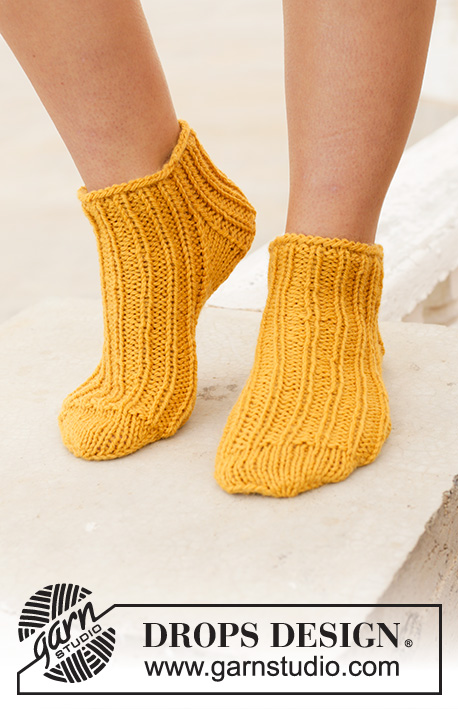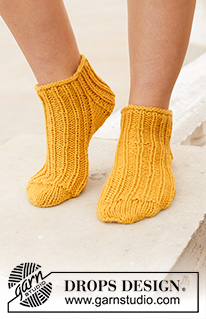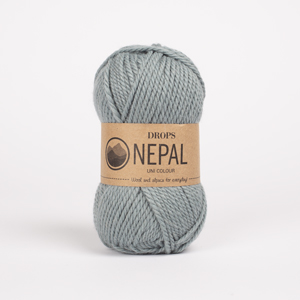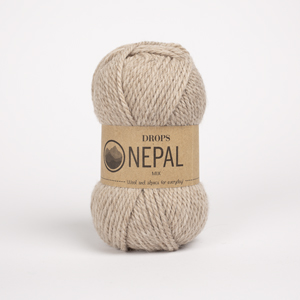Comments / Questions (21)
![]() Audrey wrote:
Audrey wrote:
Bonjour, je vais commecer ces chaussettes en 35/37. Pensez-vous qu'avec les 200 gr de Népal il y ai assez de laine pour allonger la tige d'1 cm (il me reste toujpurs de la laine quand je termine vos modèles mais je ne sais pas en quelle quantité puisque ça varie selon les modèles 😉)
01.12.2021 - 15:54DROPS Design answered:
Bonjour Audrey, il est effectivement possible que comme la quantité est la même pour toutes les tailles, vous pouvez rallonger d'un petit cm en taille 35/37, mais sans aucune garantie (nous n'avons plus ces chaussettes pour vérifier). Bon tricot!
02.12.2021 - 08:44
![]() LiseGervais wrote:
LiseGervais wrote:
Le patron on peut avoir en francais
01.10.2021 - 16:34DROPS Design answered:
Bonjour Mme Gervais, cliquez sur le menu déroulant sous la photo pour sélectionner "français". B on tricot!
04.10.2021 - 07:41
![]() Susanne Karsberg wrote:
Susanne Karsberg wrote:
Det finns flera fel i detta mönster. Stickar stl 35-37. Efter hälminskning blir det 10 maskor ej 9 kvar. Stickar upp 7 per sida då blir det 44 ej 45 m. Efter sidominskningarna 2 m vsrtannst varv 4 ggr = 30 maskor ej 37. Stickat många sockor i mina dagar och efter era flera av Drops mönster förut aldrig varit fel förut. Tacksam om ni uppdaterar detta mönster.
26.02.2021 - 11:26DROPS Design answered:
Hej Susanne, hvis du strikker 1 pind mere med indtagning til hæl, så har du 9 masker. Strikker 7 masker op på hver side = 9+7+7+22=45 m. Sidominskningar - 8 = 37 m.
26.02.2021 - 12:25
![]() Lyna Desbiens wrote:
Lyna Desbiens wrote:
Bonjour a vous Je suis en tres de tricoter votre modèle de bas J adore le modèle et la couleur wowwww Cependant votre patron est très dure a comprendre 🤔🤔🤔 Je suis déçu car j aime vraiment le modèle Je crois que les nombres de mailles qu'ils doivent rester sur les broches ne sont pas corrects ... Sa m'arrive pas Vous devriez revoir ou corriger votre patron Voilà 🤔🤔🤔
20.12.2020 - 22:27DROPS Design answered:
Bonjour Mme Desbiens, peut-être pourriez-vous nous indiquer la taille que vous tricotez et l'endroit où vous bloquez, ainsi nous pourrions vous aider à tricoter vos chaussettes?
21.12.2020 - 08:44
![]() Dominique Genelot wrote:
Dominique Genelot wrote:
Bonjour, je narrive pas a trouver les explications d un modele enfant realise en laine nepal: vert sapin et sable; je l ai vu sur l instagram de drop qui peux m aider ,je voudrais commander la laine.il s agit d un modele yoke top down je pense merci
09.12.2020 - 10:07DROPS Design answered:
Bonjour Mme Genelot, si vous pensez à cette publication, ce n'est pas un de nos modèles - (cf description de la photo) - vous pourrez retrouver tous nos pulls enfant réalisables en Nepal = laine du groupe C ici pour vous inspirer. Bon tricot!
09.12.2020 - 15:44
![]() Manon wrote:
Manon wrote:
Bonjour En taille M Il reste maintenant 36 mailles. Placer 1 fil marqueur de chaque côté, espacés de 18 mailles du dessous du pied et 18 mailles du dessus du pied. Pour que la pointe soit équilibrée, comment répartir équitablement, j'ai 15 mailles pour le dessous du pied et 21 mailles pour le dessus. Merci
01.12.2020 - 00:59DROPS Design answered:
Bonjour Manon, en 35/37 il vous reste effectivement 36 m: 21 pour le dessus et 15 pour le dessous, placez un marqueur de chaque côté dans une maille pour avoir: 17 m pour le dessus du pied, 17 m pour le dessous et 1 maille avec un marqueur de chaque côté. Bon tricot!
01.12.2020 - 09:40
![]() Janny Hilhorst wrote:
Janny Hilhorst wrote:
Eerst Hartelijk dank voor De gratis patroon. Ik wou vragen hebben jullie geen patroon als rechte lap Ben niet zomster in haken
04.08.2020 - 22:07DROPS Design answered:
Dag Janny,
Als je een rechte lap wilt haken, zou j eens kunnen zoeken op haakpatronen voor pannenlappen of dekens.
12.08.2020 - 09:05
![]() Caroline wrote:
Caroline wrote:
Bonjour, je suis rendu à la première diminution de trois mailles répartis également. Est-ce que je diminue au début, au milieu et à la fin du rang? Parce que le nombre de mailles ne sera pas égale. merci beaucoup
08.11.2019 - 14:13DROPS Design answered:
Bonjour Caroline, vous trouverez ici comment diminuer à intervalles réguliers en règle générale; pour ce modèle, je diminuerai personnellement 1 m en début de rang, 1 au milieu et 1 m en fin de rang. Bon tricot!
08.11.2019 - 14:23
![]() Fernanda wrote:
Fernanda wrote:
Can I knit these using the magic loop method instead of the DPNs?
09.07.2019 - 09:25DROPS Design answered:
Dear Fernanda, yes, you can. Happy knitting!
09.07.2019 - 10:06
![]() Marie-claire wrote:
Marie-claire wrote:
Très beau! Est-ce que le patron est disponible? Merci
25.01.2019 - 18:42
Sun Spun Socks#sunspunsocks |
|
 |
 |
Knitted socks in DROPS Nepal. The piece is worked top down with rib and stocking stitch. Sizes 35-43.
DROPS 198-14 |
|
|
------------------------------------------------------- EXPLANATIONS FOR THE PATTERN: ------------------------------------------------------- HEEL DECREASE (worked in stocking stitch): ROW 1 (= right side): Work until there are 6-6-7 stitches left, slip the next stitch as if to knit, knit 1 and pass the slipped stitch over, turn the piece. ROW 2 (= wrong side): Work until there are 6-6-7 stitches left, slip the next stitch as if to purl, purl 1 and pass the slipped stitch over, turn the piece. ROW 3 (= right side): Work until there are 5-5-6 stitches left, slip the next stitch as if to knit, knit 1 and pass the slipped stitch over, turn the piece. ROW 4 (= wrong side): Work until there are 5-5-6 stitches left, slip the next stitch as if to purl, purl 1 and pass the slipped stitch over, turn the piece. Continue decreasing like this (by working until there is 1 stitch less left before slipping 1 stitch) and until there are 10-11-11 stitches left on needle. ------------------------------------------------------- START THE PIECE HERE: ------------------------------------------------------- SOCK - SHORT OVERVIEW OF THE PIECE: The piece is worked in the round with double pointed needles, from the top of leg down to heel. The heel is worked back and forth before working the foot in the round again. SOCK: Cast on 45-48-51 stitches with double pointed needles size 4.5 mm and Nepal. Knit 2 rounds, then work rib with knit 1, purl 2. Work rib until the piece measures 4 cm in all sizes. REMEMBER THE KNITTING TENSION! Now keep the first 23-25-28 stitches on the needle for the heel and the last 22-23-23 stitches are placed on 1 thread (= mid top of foot). Work rib as before back and forth over the heel stitches for 5-5½-6 cm. NOTE! On the last row from the wrong side decrease 3-4-5 stitches evenly by knitting 2 stitches together in the purl sections (seen from the right side) = 20-21-23 stitches for the heel. Insert 1 marker in the piece and measure from here onwards. Now work HEEL DECREASE – see description above! After the heel decrease knit up 7-9-11 stitches along the one side of the heel, place the 22-23-23 stitches from the thread back on the needles, work these stitches and then knit up 7-9-11 stitches along the other side of the heel = 46-52-56 stitches. Insert 1 marker thread on each side of the middle 21-23-23 stitches on top of foot. Continue with rib on top of foot and stocking stitch underneath the foot and beside the heel - AT THE SAME TIME decrease in each side as follows: The last 2 stitches before the first marker on top of foot are knitted twisted together (i.e. you work in the back loop of the 2 stitches rather than the front) and the first 2 stitches after the last marker on top of foot are knitted together. Repeat this decrease every 2nd round a total of 5-7-7 times = 36-38-42 stitches. Continue working until the piece measures18-20-22 cm from the marker on the heel (= approx. 4-4-5 cm left to full length). So that the toe is even decrease as follows on the next round: Size 35/37: Decrease 2 stitches over the purl sections on top of foot (decrease by purling 2 stitches together). Sizes 38/40 and 41/43: Decrease 1 stitch in the first purl section and 1 stitch in the last purl section on top of foot (decrease by purling 2 stitches together). There are now 34-36-40 stitches left on needle. Insert 1 marker thread in each side so that there are 17-18-20 stitches under the foot and 17-18-20 stitches on top of foot. Work stocking stitch and decrease for the toe as follows: Knit twisted together the 2 stitches after both marker threads and knit together the 2 stitches before each marker thread. Repeat this decrease every 2nd round a total of 4-4-4 times, then every round a total of 3-3-4 times = 6-8-8 stitches left on needle. Cut the strand, pull it through the remaining stitches, tighten and fasten well. Work 1 more sock in the same way. |
|
Have you finished this pattern?Tag your pictures with #dropspattern #sunspunsocks or submit them to the #dropsfan gallery. Do you need help with this pattern?You'll find 22 tutorial videos, a Comments/Questions area and more by visiting the pattern on garnstudio.com. © 1982-2025 DROPS Design A/S. We reserve all rights. This document, including all its sub-sections, has copyrights. Read more about what you can do with our patterns at the bottom of each pattern on our site. |
|


























































Post a comment to pattern DROPS 198-14
We would love to hear what you have to say about this pattern!
If you want to leave a question, please make sure you select the correct category in the form below, to speed up the answering process. Required fields are marked *.